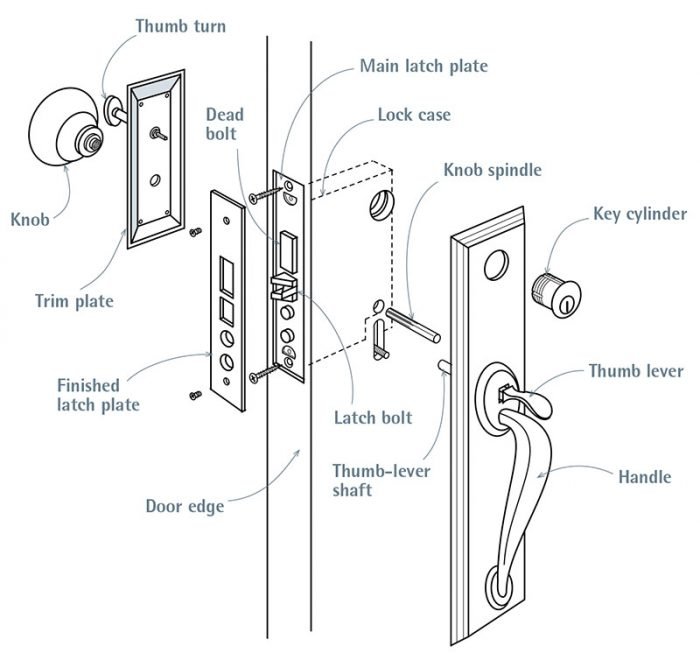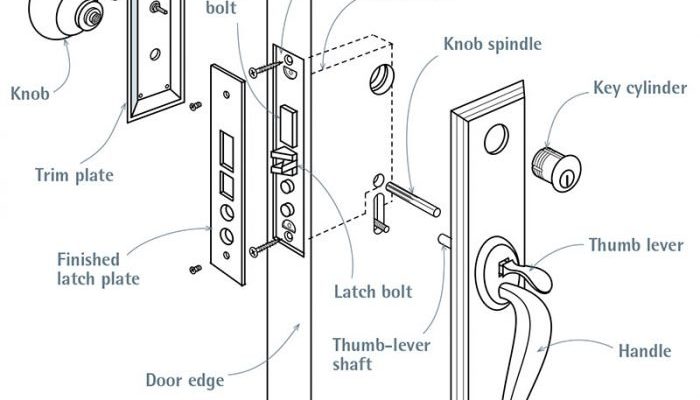
Here’s the thing: mortise deadbolts, whether made by Schlage, Yale, or a lesser-known brand, tend to collect dust and grime inside the mechanism over time. Unlike modern cylindrical locks that mostly get ignored, these classic locks actually benefit from a bit of simple maintenance. But not every mortise deadbolt should be lubricated, and doing it wrong can make matters worse. Let me walk you through when, how, and why to lubricate a mortise deadbolt, plus a few beginner-friendly tips (and things to avoid) along the way.
Why Lubrication Matters for Mortise Deadbolts
Keeping your mortise deadbolt well-lubricated isn’t just about smoother locking and unlocking. A clean, well-oiled mechanism can actually extend the lifespan of the lock and help you avoid bigger problems down the road. Most people don’t think about the inside of their deadbolt until something goes wrong—maybe the key won’t turn, or you notice it sticks halfway. Usually, this comes down to a buildup of dirt, dust, or just dried-out parts that need a little extra help.
Mortise deadbolts are unique. Instead of just being a simple cylinder, they house an entire mechanism inside the door. Think of it like the engine under your car’s hood—hidden away but essential. Left untreated, friction wears down the internal parts, which can make the lock harder to use and even damage the key itself. On high-traffic doors or in older homes (where Schlage and Yale mortise locks are still common), these little issues become big annoyances fast.
Regular lubrication acts like preventive medicine. By taking a few minutes to do it right, you’ll keep everything moving freely. It can also help if you’ve recently reset or repaired the deadbolt, or after troubleshooting a stubborn lock that didn’t respond to a quick fix. Bottom line: lubricating your mortise deadbolt—if your lock type allows it—means less frustration and more peace of mind.
How to Tell if Your Mortise Deadbolt Needs Lubrication
You might be wondering, “Does my mortise deadbolt even need this?” Not every sticky lock needs lube—and some really shouldn’t get any at all. Let’s break down the telltale signs that your lock could use a little help:
- Difficulty turning the key: If you have to wiggle, force, or jiggle your key, something inside may be drying out.
- Grinding or squeaking sounds: Odd noises are a classic warning that metal parts are scraping together.
- Visible gunk or debris: Take a look at the keyway (where you insert the key). If you see dust, flakes, or residue, that’s a clear sign.
- Key comes out dirty: Pull out your key after use. If it’s got dark stains, metal shavings, or feels gritty, the inside mechanism is probably overdue for a cleaning and lubricating session.
But here’s an important note: mortise deadbolts used with electronic or smart lock conversions (where you’ve added code or battery-powered features) sometimes have components that aren’t meant for traditional oil or spray lubricants. Check your manual, or look up your lock’s model online before proceeding. Some brands, especially modern Yale or Schlage units, warn against certain products.
What Kind of Lubricant Should You Use?
Not all lubricants are created equal—especially for locks. You might see old-school advice to just spray WD-40 everywhere, but honestly, that’s not a good idea for most mortise deadbolts. WD-40 isn’t really a long-lasting lubricant; it’s more of a solvent, and it can actually attract more dirt, turning your lock into a sticky mess.
Instead, reach for a specialty lock lubricant. Here are your best options:
- Graphite powder: This dry lubricant is a top pick for traditional mortise deadbolts. It won’t gum up over time, and it’s safe on delicate mechanisms.
- PTFE (Teflon) spray: These are often labeled as “dry lube.” They leave a thin, slick coating without the stickiness or residue of oil-based products.
- Silicone spray: Only use this if your manufacturer specifically recommends it—some modern locks (especially with reset or code-driven parts) need silicone, but it should be a dry formula.
If your mortise deadbolt is integrated with a battery-powered smart feature, double-check before lubricating. Certain lubricants can damage plastic gears or electronic contacts. As a rule, don’t use oil-based or greasy products—they’ll just collect dust and turn into sludge.
Step-by-Step Guide: How To Lubricate a Mortise Deadbolt Mechanism
Let me explain how you actually get the job done—from prepping your lock to cleaning up. This method works for most classic mortise deadbolt brands like Schlage, Yale, or unbranded models, but always err on the side of caution if you’re unsure.
- Gather your tools: You’ll want a small screwdriver, a soft cloth or paper towel, your chosen lock lubricant (graphite powder or PTFE spray), and maybe a flashlight for better visibility.
- Open the door so you can work comfortably. You don’t want to get stuck on the wrong side!
- Remove the lock cover (if needed): Some mortise deadbolts have small screws securing an outer faceplate. Carefully unscrew these and set the plate aside. If yours doesn’t have visible screws, just work through the keyway.
- Apply lubricant: Insert the nozzle of your lubricant right into the keyway. If you’re using graphite, puff a little powder in. With spray lubricants, just a half-second burst will do—less is more. Avoid soaking the inside.
- Work the mechanism: Insert and remove the key several times, locking and unlocking the deadbolt to distribute the lubricant inside. Wipe off any excess lubricant that comes out on your key.
- Reassemble (if you disassembled anything): Put the faceplate and screws back. Test the lock a few more times for smoothness.
Don’t forget: If you’re unsure whether your lock is safe to lubricate, especially with electronic or battery-operated parts, contact the manufacturer or a locksmith before proceeding.
What to Avoid When Lubricating a Mortise Deadbolt
It’s easy to make mistakes here, especially if you’re new to lock maintenance. Here are some classic “don’t do this” moves I’ve seen more than a few people try:
- Don’t use household oils: Products like 3-in-1 oil or cooking spray will gum up and make things worse over time.
- Don’t drown the mechanism: A little lubricant goes a long way. Spraying too much can make it harder for the parts to move and attract more dirt.
- Don’t force the key: If it’s still tough to turn after lubricating, there could be a bigger issue. Forcing it can snap the key or damage the lock.
- Don’t skip a reset or troubleshooting if you have a smart or coded lock: Some mortise deadbolts paired with remotes or code panels might need to be reset after fiddling, especially if the mechanism feels different.
If you’re ever not sure what’s going on, it’s better to pause and ask a pro. The cost of a locksmith call is much less than replacing a ruined deadbolt—trust me, I’ve seen that regret more times than I’d like.
What If Lubricating Doesn’t Fix Your Mortise Deadbolt?
Sometimes you’ll do everything right and the deadbolt still feels stubborn. At this point, it’s time to look for bigger issues. You could be dealing with a misaligned strike plate, worn internal parts, or even a key that’s become deformed over time. In universal mortise locks, older keys can get bent just enough to cause trouble that lubrication alone won’t solve.
For locks with electronic features—like those you can code, sync, or pair with a remote—troubleshooting goes a bit deeper. You might need to check the battery, reset the digital panel, or update the firmware. In some cases, cleaning the mechanical parts helps, but you’ll want to avoid getting lubricant on any of the electronic bits.
A professional locksmith can often diagnose the problem quickly, and if the lock is truly beyond repair, they can recommend a compatible replacement. Honestly, if you’ve tried all the usual steps and your lock still sticks, don’t force it. You’ll save yourself time and frustration by getting help.
Alternative Solutions: When Lubrication Isn’t Enough or Not Recommended
Here’s a scenario—that mortise deadbolt is clearly not responding to lubrication, or maybe you discover your model shouldn’t be lubricated at all (this occasionally happens with remotes or specialty smart locks). Now what?
- Mechanical adjustment: Sometimes, the deadbolt is misaligned with the door frame. Adjusting the strike plate or tightening screws can make a world of difference.
- Professional cleaning: On older Schlage or Yale mortise deadbolts, a locksmith can do a deep dismantling and reassembly, cleaning out every bit of dirt and debris.
- Upgrade options: If you’re tired of fussing, consider swapping your mortise lock for a modern, compatible model. Some Yale and Schlage mortise bodies now support code or remote features—making maintenance easier in the long run.
In cases where lubrication is specifically not recommended (maybe the model is marked “maintenance-free” or has electronic contacts), stick to dry cleaning and mechanical fixes. It’s better to be a bit cautious than to wreck a high-end mechanism with the wrong product.
Keeping Your Mortise Deadbolt Running Smoothly Over Time
Now that you’ve got your mortise deadbolt turning like new, how can you keep it that way? Routine is your friend. Plan to check your lock every six months or so—just give it a twist and listen for grinding or stiffness. If you live somewhere especially dusty, or if you use your door dozens of times a day, you might want to lubricate it a little more often.
Don’t forget to monitor your key, too. If it suddenly starts pulling out metal filings or getting harder to insert, that’s your signal. For those using locks with code, battery, or remote features, also keep an eye on your battery life and software updates, especially if troubleshooting doesn’t fix a sticky lock.
The small effort of keeping things lubricated pays off in reliability, security, and peace of mind. After all, a smoothly-turning deadbolt is one less thing to worry about in your busy day.
Wrapping Up: Better Locks, Less Frustration
Lubricating a mortise deadbolt isn’t rocket science, but it does take a bit of know-how and the right product. Whether you’re caring for a vintage Yale lock, a modern Schlage, or any other brand, a little regular attention keeps your doors secure and your keys gliding smoothly—without all the drama of stuck locks or emergency locksmith visits.
You don’t have to be an expert to keep your home’s security hardware running smoothly. With a reliable lubricant, a bit of caution (especially with smart or battery-powered models), and a willingness to ask for help when you need it, you’ll make life easier for yourself—and maybe even impress your friends next time someone’s lock gets stubborn. In the end, good maintenance isn’t just about the lock; it’s about making your daily routine a little simpler and safer.
